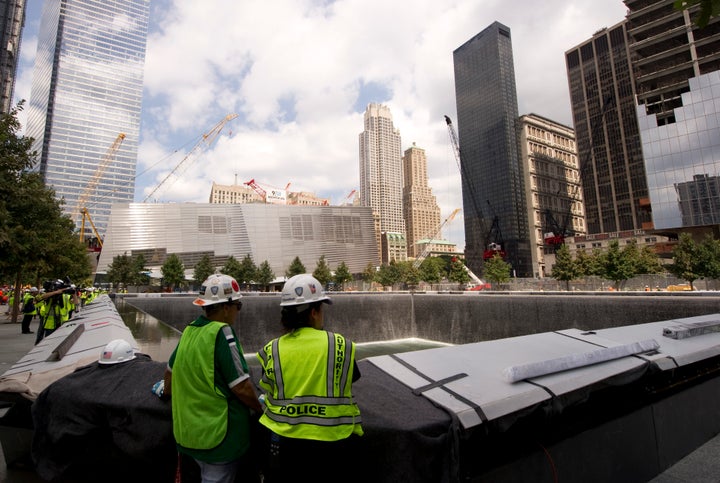
"Urgent," the message read:
"ATTIRE GUIDELINES AT THE WORLD TRADE CENTER SITE: The World Trade Center site is an active construction site. Please read the following guidelines carefully. These rules are strictly enforced by on-site security personnel and you may be denied access if they are not followed."
At the invitation of Professor Burton Visotsky at Jewish Theological Seminary (JTS), I was about to join a small group of interfaith visitors on a personally-guided tour of the 9/11 Memorial with Architect Michael Arad. I had been fortunate enough to participate just a few weeks earlier in "Our Better Angels," a discussion series co-sponsored by JTS and Union Theological Seminary which brought together Jewish, Christian, and Muslim leaders and the public to discuss our faith-based approaches to trauma, mourning, and healing and to help prepare us for the 10th Anniversary of 9/11. A visit to the memorial site seemed a natural continuation of the work.
Yet, as I imagined myself wearing a construction hardhat atop my hijab, it suddenly hit me that I was about to pay a visit to the 9/11 Memorial looking identifiably Muslim. Perhaps it meant nothing. Yet, I felt somehow that I was carrying the heavy story of 9/11 and terrorism in the symbol of my headscarf. I wondered how I would be seen by the architect, or the construction workers. As they engaged in the act of building up a space destroyed by people who are seen as Muslim, who claimed to be Muslim, would they see me and remember the perpetrators? Or would I be viewed as just another visitor, another human being?
The next morning, my Jewish, Christian, Sikh, and Hindu American colleagues and I met with Michael Arad. Putting on my construction vest and the hard hat, I shared my worry about standing out. I asked Mr. Arad if he had previously seen any other Muslim woman in hijab walk through the site. "I don't think so," he replied. He quickly added, "The site is not meant to exclude anyone though." As he shared with us how he had been inspired by seeing spaces like Washington Square Park, where people came together in the days after 9/11, I was reassured. I understood then that it was really my own internalized anxieties coming to the fore -- my worries about how others would see me reflected my grappling with how Islam and Muslims are seen as a result of 9/11. I know it is similar to the journey of many American Muslims, whose religious identity has become more salient, sometimes against our will.
Walking to the Memorial meant first crossing construction in progress below the plaza level. As we stepped into the mud and uneven ground, I was jolted by the pain of lost lives. I felt I could almost hear the panic and screams of those who must have suffered on that day, and felt tears welling up to suffocate me. It seemed almost too much to continue and I felt an urge to turn back, to escape the pain. But something kept pushing me forward. Only a few steps later, we climbed the stairs to the Plaza to view "Reflecting Absence," the 9/11 Memorial designed by Mr. Arad.
The sight of trees and sound of flowing water transported us into another emotional space, one that is simultaneously empty and yet, healing. My eyes were drawn to the beginning of the waterfall on each side of the pool, where individual streams shimmered at their origin in the morning light and cascade into a larger pool. Looking down into the water, I remember that this space, now a void, was once full of life and the commerce of our World Trade Center.
Surrounding the pool, a continuous series of bronze panels with names has been covered with cloth and sturdy plastic sheeting, out of respect to the family and friends who will be the first to see these names. Each name is cut hollow into the metal, and night time visitors will see the lights below the panels shine through the carved letters, illuminating the void cast by the loss of each person. Mr. Arad also spoke of the many months it took to arrange the nearly 3000 names of those who died in 2001 and 1993. About 1500 family members responded to outreach, making specific requests about adjacent names. These names are grouped to show relationships between couples, colleagues, and friends. We felt reassured by his compassion and thoughtfulness, that as visitors come to the 9/11 Memorial, they will remember not only each unique person but also be comforted by the relationships and the community surrounding their loved ones.
Looking around, I saw reflections of the ongoing construction in the water, in the glass windows of buildings around us. Young oak trees with silver-green leaves are taking root all around the plaza. Set within the emptiness of missing buildings and missing lives, these small signs of change and growth bring a sense of wholeness, a reminder about the cyclical nature of life and death, that some of us must stay behind while others of us move on. Michael Arad was right: the Memorial is a place of togetherness, as it should be. It reminded me that while we may grapple with questions of identity and place, ultimately we are connected through our humanity.